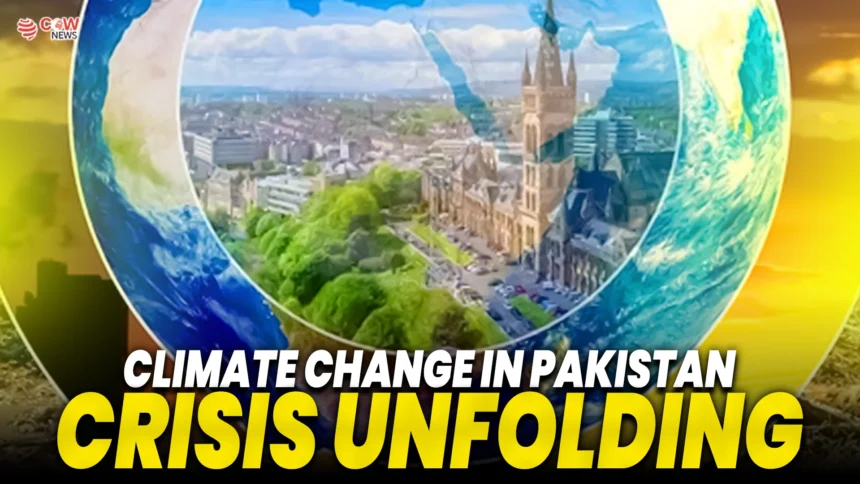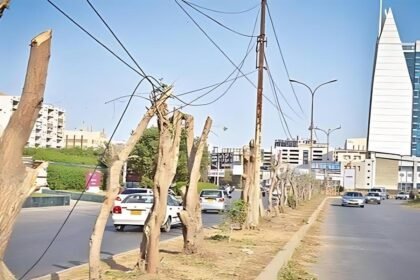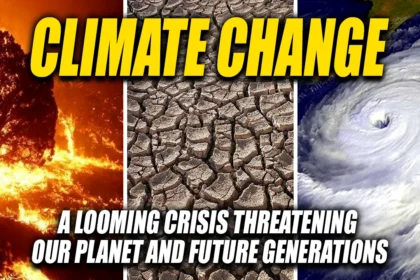By Faizan Hussain
Climate change is no longer just a scientific term—it has become the world’s most pressing and silent crisis. It affects weather patterns, water resources, agriculture, energy, health, the economy, and even our daily lives. But when we talk about developing countries like Pakistan, this crisis is not just environmental—it morphs into an economic, social, and even national security challenge.
Pakistan ranks among the top 10 countries most vulnerable to climate change, despite contributing less than 1% to global greenhouse gas emissions. Yet, we are among the first and hardest hit by its impacts—floods, droughts, water scarcity, agricultural devastation, and energy crises.
Today, we examine how climate change is reshaping Pakistan’s economy, agriculture, water resources, energy sector, public health, education, and social stability. More importantly, we ask: Is our government, institutions, and society prepared to face this looming catastrophe?
According to the Global Climate Risk Index, Pakistan is one of the most climate-threatened nations. Industrialized nations, responsible for the bulk of carbon emissions, have triggered rising global temperatures, melting glaciers, erratic weather, and rising sea levels. Pakistan’s geographical diversity—glaciers in the north, coastal areas in the south, deserts in the west, and fertile plains in the center—makes it a hotspot for climate disasters.
Agriculture contributes nearly 19% to Pakistan’s GDP and employs over 40% of the workforce. But climate change is disrupting this lifeline. Unpredictable rainfall, heatwaves, pest outbreaks, and water shortages are slashing crop yields.Cotton, the backbone of Pakistan’s textile industry, is suffering due to extreme heat and erratic monsoons. Wheat and rice production has declined due to delayed planting and water shortages. Sugarcane faces reduced yields from prolonged droughts and rising temperatures.
The fallout? Farmers’ incomes are shrinking, agricultural laborers are losing jobs, and food insecurity is rising. The World Food Programme estimates that 40% of Pakistan’s population faces food insecurity—a ticking time bomb.
Pakistan is among the world’s most water-stressed nations. Melting glaciers, unpredictable rainfall, and poor water storage infrastructure are exacerbating the crisis. Both floods and droughts are becoming the new normal.
- The 2022 floods, among the worst in history, caused $30 billion in economic losses, displaced millions, and destroyed vast agricultural lands.Droughts in Balochistan, Sindh, and South Punjab are turning fertile lands barren, forcing mass migrations of humans and livestock.Without urgent action, Pakistan could face absolute water scarcity by 2025.
Pakistan’s energy sector heavily relies on hydropower, which depends on river flows and glacial melt. But erratic water supplies disrupt electricity generation.Rising temperatures increase demand for cooling, straining the power grid.Load-shedding worsens, crippling industries and daily life.ransitioning to solar, wind, and other renewables is no longer optional—it’s a necessity.
Climate change is a silent killer, worsening diseases and malnutrition. Floods trigger outbreaks of cholera, dengue, and typhoid.Heatwaves cause heatstrokes and cardiovascular diseases.Malnutrition weakens immunity, especially in children and women.Pakistan’s healthcare system, already underfunded, is ill-prepared for this growing burden.
Natural disasters destroy schools, disrupt education, and push children—especially girls—into child labor.
National Climate Change Policy Green Pakistan Initiative (reforestation) Renewable energy projects (solar, wind) But corruption, poor implementation, and lack of funding hinder progress. NGOs promote climate awareness, tree planting, and sustainable farming. International funds (e.g., Green Climate Fund) support adaptation projects.However, transparency in fund utilization remains a challenge.
Also read: Climate Change: A Growing Threat to Our Future
Pakistan advocates for climate reparations from high-emission nations. The Loss and Damage Fund (COP27) is a start, but richer nations must fulfill their pledges.Climate change is no longer a distant threat—it’s Pakistan’s present reality. Without urgent action, we face:Economic collapse from agricultural ruin. Water wars as scarcity intensifies.Health crises from pollution and disease.A lost generation deprived of education.
What Must Be Done?
- Invest in Climate-Resilient Agriculture (drought-resistant crops, modern irrigation).
- Build Water Storage Infrastructure (dams, rainwater harvesting).
- Shift to Renewable Energy (solar, wind, hydropower).
- Strengthen Disaster Preparedness (early warning systems, flood barriers).
- Demand Climate Justice (hold polluters accountable).
Climate change is no longer a distant threat looming on the horizon; it has become an immediate and pressing global crisis. While Pakistan is among the countries most vulnerable to the devastating impacts of climate change, this challenge transcends borders and demands collective action from the entire international community. The stark reality is clear: the choice before humanity is simple—adapt or perish.
Pakistan’s struggle with climate change is a sobering example of the crisis unfolding worldwide. The country faces severe floods, prolonged droughts, heatwaves, and unpredictable weather patterns that have disrupted millions of lives and shattered livelihoods. These climatic events have caused massive damage to agriculture, infrastructure, and public health, exacerbating poverty and threatening food security. Yet, Pakistan is far from alone in this battle.
Globally, rising temperatures have intensified extreme weather events. From devastating wildfires in Australia and California to melting polar ice caps and rising sea levels threatening low-lying island nations, no region remains untouched. Scientists warn that if global greenhouse gas emissions are not drastically reduced, the planet could face irreversible damage within decades. The consequences will be catastrophic—widespread displacement, loss of biodiversity, food and water shortages, and increased conflict over dwindling resources.
Addressing climate change requires unprecedented cooperation among nations. It calls for comprehensive policies focused on reducing carbon emissions, transitioning to renewable energy, protecting natural ecosystems, and investing in climate-resilient infrastructure. Developed nations, which historically contributed the most to carbon emissions, bear a significant responsibility to lead this global effort and support vulnerable countries through funding and technology transfer.
Equally important is empowering communities to adapt to changing climates. This includes improving disaster preparedness, developing sustainable agriculture practices, and enhancing water management systems. Adaptation strategies must be locally tailored and inclusive, ensuring that marginalized groups and developing regions are not left behind.
Time is of the essence. The window for meaningful intervention is rapidly closing. The longer the world delays, the greater the environmental, social, and economic toll will be. Pakistan’s plight serves as a wake-up call to the international community that climate change is a shared problem requiring shared solutions.
In conclusion, climate change is not just Pakistan’s problem—it is humanity’s greatest challenge. The imperative is clear: act decisively now, embrace innovation and collaboration, and commit to a sustainable future. Failure to do so will leave us with no option but to endure irreversible consequences. Adapt or perish—there is no middle ground.







